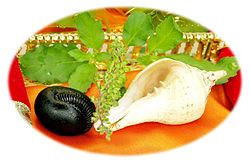- Dakshinavarti Shankh
-
Dakshinavarti Shankh, Valampuri Sangu [in Tamil] or Sri Lakshmi Shankh, is a sacred Hindu object otherwise known in English as a conch shell. This is the shell of a large sea snail from the Indian Ocean (a shell of the species Turbinella pyrum), but one that has the very rare reverse-turning spiral.
In other words, when it is held with the spout (siphonal canal) pointed up, this conch's spiral twists rightwards (dakshinavarti) rather than very much more common form, which twists leftwards (vamavarti)[1][2].
Contents
True vs. fake
The genuine Lakshmi Shank is a sinistral conch shell from the Indian Ocean, and certainly not a sinistral whelk species from Florida, USA. A true Valampuri shell is a species under the gastropod genus Turbinella L. The most common species is Turbinella pyrum L. It is important to note that only sinistral variety of Turbinell species is a true Lakshmi Shankh. This shell is rare in its occurrence. Other right-turning sea snail shells of a similar shape such as the lightning whelk Busycon perversum, are often mistakenly sold and worshipped in place of the genuine Shank. The real Lakshmi Shank has 3 to 7 ridges or plaits on its columella, whereas whelk shells does not show the presence of such plaits on its columella. The so called flower bud opening test, rice pulling test, Valampuries coming up through the rice heap are non scientific and are gimicks.
Valampuries show much morphological variations depending on its natural locality. Shells with mixed characters of two adjacent localities are also seen.
Origin
While genuine Dakshinavarti Lakshmi Conches are only found in the Indian Ocean, between Myanmar (Burma) all the way to Sri Lanka. There are three main localities of this shankh in India. Shells from all the localities show definite morphological variations. The three localities are Indian Ocean near Adam's Bridge (Ram Setu), Sri Lanka, Ramishwaram to Tuticorin. Shells from this region are rare in occurrence. The second locality is Arabian Sea or Western India. The third locality is Bay of Bengal. Varieties showing mixed characters have also been observed. The imitation (Lightning Whelks) mostly come from Florida and the Gulf of Mexico. This imitation is also known as African Valampuri.
Rarity
Real Lakshmi Conch (right side spinning) are estimated to occur only one per 100,000 conch shells. The shell of the lightning whelk on the other hand almost always opens on the right. Valampuries with five plaits or folds in its cavity are known as 'Panchajanya' and are very rare. Completely snowwhite Valampuries are also very rare and expensive.
Powers ascribed
The Lakshmi Conch is said to bring all manner of blessing, but particularly material wealth, upon the owner. Ritual use may include bathing deities, drinking from the conch, or the use of mantras oriented to goddess Lakshmi.
Current value
A true Dakshinavarthy shell is sold on weight basis. The present market cost in India falls in the range of Rs. 1500/- to Rs. 3500/- per gram. However, there have been some reports that shell is also sold up to Rs. 10000/- per gram. Based upon a market search of a number of genuine sellers, the price was average of Indian Rs. 6,000 per gram, depending on size, type, and quality, price can be much higher. For example a medium size Valampuri weighs about 160 grams x Rs 6,000 = Rs. 960,000 (US$ 20,528) minimum. More over, Valampuris of the smooth "milk" variety sell for over Rs. 20,000 per gram, and weight about 150-350 grams. Tiny dwarf Valampuris small enough to wear as a pendant are very rare and price is negotiable when available. Regarding value, note the comparison, a Valampuri costing $20,000 would only purchase a 1.50-carat (300 mg) diamond. So the legendary cost of Valampuri, as compared to a diamond, is actually quite low, in spite of demand always far exceeding supply[3].
See also
References
- ^ "Article on Valampuri - Weblink". http://www.navaratna-museum.info/Shells.html. Retrieved 2009-11-08.
- ^ "Article on Valampuri - Weblink". http://www.p-g-a.org/valampuri-artl.html. Retrieved 2009-11-08.
- ^ Taecharongroj, Paitoon (2006). The Legend of Shankha. Rabitgoldgroup. ISBN 974-94646-4-8.
Categories:- Gastropods
- Hindu symbols
- Commercial molluscs
- Strombidae
- Endangered species
- Symbols
- Natural horns
Wikimedia Foundation. 2010.

